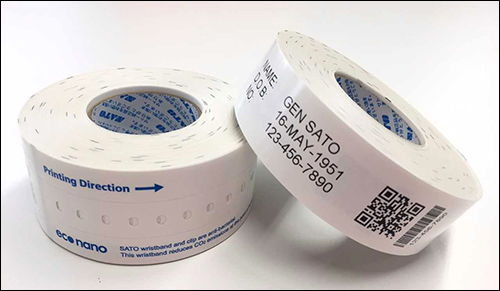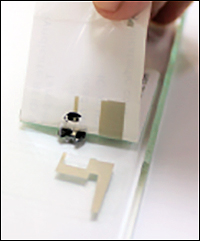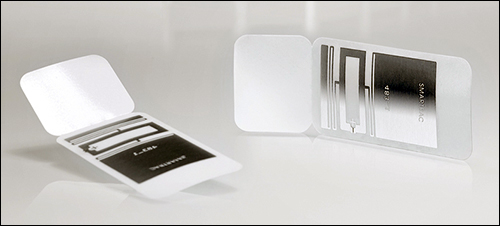The following are news announcements made during the past week by the following organizations:
Identiv, S+P Samson GmbH;
SATO Europe;
Syndicate Secure Print;
Smartrac;
GlobalPlatform; the
European EPC Competence Centre; and
HID Global.
Identiv, S+P Samson GmbH Partner on Thin RFID Labels for Medical Devices
Identiv has announced that it has partnered with S+P Samson GmbH to produce a system for tracking surgery instruments and medical devices using radio frequency identification technology. Working with hospitals and Identiv, S+P Samson has developed a thin, small ultrahigh-frequency (UHF) RFID label that can be affixed to stainless steel and plastics, such as medical instruments. With a UHF inlay, the company reports, the label can withstand cleaning, disinfection or hot steam treatments.
Identifying medical instruments that need to be sterilized can be accommodated via RFID, the companies explain. This, they say, makes it easier for hospitals to track the number of sterilization cycles, and to accurately monitor instrument lifetimes. Traditionally, the administration of medical instruments has required extensive manual labor. With RFID, the storage location, correct maintenance, age and other parameters of hospital instruments and devices can be monitored quickly and automatically.
“S+P Samson searched out the right company to connect with to engineer the necessary UHF inlay,” said Stephane Ardiley, Identiv’s director of product management for credentials, in a prepared statement. “Identiv is an expert in designing and manufacturing high-frequency (HF) and UHF transponders for embedded use in everyday objects, including medical devices, books, toys, and athletic apparel.”
Identiv’s transponders can be delivered in different form factors, including labels (printed or non-printed), dry inlays, wet inlays (with backing adhesive), tickets and more, and can be provide RFID connectivity to objects in the Internet of Things market. S+P Samson provided a dry inlay with a diameter of 5.4 millimeters (0.2 inch), made of polyimide (PI) substrate and copper lines. This inlay chip complies with the ISO 18000-6C standard.
“We chose to work with Identiv because of the team’s expert engineering and flexibility,” said Michael Boisson, S+P Samson’s head of product development. “Identiv is highly skilled in the Internet of Things market and provided us with the right tools to make our product a reality. Working together, we are protecting patients in an ever-evolving world.”
SATO Europe Launches New RFID-enabled Patient ID Wristbands
SATO Europe, a provider of automatic-identification and labelling solutions, has unveiled a new range of ID wristbands for the health-care sector. The wristbands are designed to enhance patient safety, security and comfort, according to the company. Four new wristband lines have been launched as part of SATO Europe’s Thermal Transfer (TT) Line wristband: the Direct Thermal (DT) Line, the Eco Line, the Laser Line and the RFID Line.
“We can now offer a complete portfolio of patient ID wristbands to the healthcare sector that suit individual patient needs and are fit for specific hospital environments and stay durations,” said Kevin Allart, SATO Europe’s health-care business-development manager, in a prepared statement. “Healthcare professionals benefit from optimum flexibility and cost-effectiveness in the choice of wristband whilst ensuring patient safety is protected at all times due to accurate data collection and identification. For patients, the ID wristbands have been designed to be comfortable to wear and non-irritable to skin whilst providing peace of mind and convenience.”

The four wristbands have been developed to offer hospitals and other health organizations cost-effective ID solutions for short stays and outpatients, the company reports. The RFID Line offers health-care facilities autonomy, patient safety and security. Customers can choose from HF, UHF and NFC technologies, depending on the scenario.
Hospital personnel can scan and track patients from a distance using strategically placed RFID readers or mobile devices, minimizing the need to disturb them for data collection. The RFID technology can also be used to manage access to departments or wards—for example, maternity or mental health units. The RFID wristbands are printed using direct-thermal technology, providing a high-quality print that can retain data securely for up to one week.
“We understand that there is no one-size fits all solution to patient safety and security; that’s why we have extended our range of ID wristbands,” Allart said in the prepared statement. “Now, we can offer customers in the healthcare sector a comprehensive, cost-effective selection of wristbands that deliver error-free, accurate identification data. SATO has been involved in the development of fail-safe solutions for positive patient identification for more than two decades. We have worked with hospitals and healthcare organizations to deliver solutions that withstand the harsh hospital environment whilst preserving patient data securely and safely to provide peace of mind to patients and healthcare professionals alike.”
Syndicate Secure Print RFID Windshield Label Doubles as License Plate
Syndicate Secure Print has announced its Crystal 3rd License Plate, a non-transferrable, tamperproof RFID windshield label. With IR and UV light protection, the company reports, the tag can be applied to windshields, with a read range of up to 10 meters, depending on the reader.
With conventional RFID windshield tags, users are limited to printing variable data on the side, which faces the inside of the vehicle. This, the company explains, restricts visual means of identification. The Crystal 3rd License Plate label is designed to allow a user to print variable data on demand, which can then be read from outside a vehicle. According to the company, the tag is suitable for applications requiring a visual means of identification.

Typical application includes use as a parking permit, for which a label can remain on a windshield for the lifetime of that vehicle, with permit extensions carried out electronically. Multiple permits can be clubbed into the same windshield tag. Other applications include electronic vehicle registration, emissions inspection, fleet management and toll collection.
Most conventional RFID windshield labels can be removed without tamper and are thus transferrable. The Crystal 3rd License Plate label features a tamperproof construction. If any attempt at removal is made, the label will not come off intact, thereby making it impossible for the label to be transferred to another vehicle. In addition, the company produces a range of RFID and NFC tamperproof, non-transferrable labels for anti-counterfeit, theft-prevention and brand-protection applications.
Smartrac Intros Tag for Metallic Surfaces, Everyday Objects
RFID and Internet of Things (IoT) solutions company Smartrac has announced its Midas FlagTag, designed for use on consumer goods and industrial components with metallic, plastic and cardboard surfaces.
The Midas FlagTag design uses the metallic surface as part of the antenna structure. This helps to improve performance in less demanding physical environments, the company reports, while providing cost advantages compared to foam-based inlays and hard tags typically designed for use on surfaces in tougher industrial environments.

Traditionally, tagging metallic packaging and liquids has presented a challenge in many applications. The Midas FlagTag is intended for use in authenticating pharmaceutical, retail, health-care and industrial items, as well as for supply-chain and asset-management applications.
The tag features an Impinj Monza R6 IC and utilizes RAIN RFID technology, based on the UHF RFID protocol standard developed by GS1 and ISO. Additionally, the tags are suitable for full IoT integration into Smartrac’s Smart Cosmos enablement platform.
The Midas FlagTag has a small form factor with a total size of 60 millimeters by 21 millimeters when used as a standard flat paper tag. As a special feature, a flag can be created at the end of the tag with a final paper tag size of 43 millimeters by 21 millimeters after folding, and with an exposed area of 17 millimeters by 21 millimeters.
The folded part of the tag sticks out of the metal resembling a flag, the company explains, and the attached antenna part uses the metal surface as part of the antenna structure to increase tag performance. Read distances of more than 10 meters can be achieved, depending on the geometry and size of the metal object. The tags are compatible with RFID printers for easy printing and encoding.
GlobalPlatform Publishes On-Device NFC Service-Management Specification
GlobalPlatform has announced that its Managing Entity Specification has been published, completing a stack of complementary software standards from ETSI and the NFC Forum. The new standard, according to the company, ensures that multiple mobile contactless services can coexist within a device and operate as intended, regardless of the hosting environment selected by a service provider. The standardized approach provides clarity to service providers offering NFC services in smartphones and other devices, and benefits OEMs developing devices that support NFC services.
Earlier this year, ETSI, GlobalPlatform and the NFC Forum reviewed their specifications on implementing and managing NFC services across all technologies and platforms. The output of this collaboration is a standardized approach detailed in a white paper titled “Ensure Interworking Between Multiple Contactless Card Emulation Environments.”
The GlobalPlatform Managing Entity Specification is supported by the latest versions of ETSI TS 102 622 and NFC Forum NCI Technical Specification Version 2.0, which is slated to be published later this year. “The behavior of NFC services can be unpredictable due to a lack of implementation clarity, impacted by factors such as the model and configuration of a device,” said Gil Bernabeu, GlobalPlatform’s technical director, in a prepared statement.
“The framework provided by the stack of specifications addresses this,” Bernabeu added in the prepared statement. “It offers a consistent approach suitable for the mass market to the deployment and lifecycle management of NFC services to ensure service delivery is not compromised by the external device environment. This level of uniformity not only brings benefits to service providers, but also ensures that consumers can activate NFC services as and when they need to.”
The specification provides a mode that is backward-compatible to all secure elements already in the field. It supports the activation of multiple NFC services at the same time within a single device, independent of the hosting environment, and has the ability to detect potential conflicts. What’s more, it details how to simplify the end-user experience when selecting NFC services for entities such as mobile wallet providers.
European EPC Competence Centre Issues Reference Document Discussing UHF RFID
The European EPC Competence Centre (EECC) has documented the state-of-the-art of UHF RFID transponders with its reference document known as the “UHF Tag Performance Survey,” which has been published annually since 2007. The report helps users to stay abreast of relevant technical parameters, the organization reports, and to use transponders optimally in existing and new applications.
More than 9,200 test series were conducted to measure 225 transponder labels from 28 manufacturers and 159 on-metal tags from 16 manufacturers. Each test series checked the transponder’s suitability in a practical process. Three new chip types and five new transponder manufacturers were tested for this annual benchmark report
Manufacturers are following the trend toward more intelligent sensors in the Internet of Things (IoT), the EECC reports, and eight of the tested passive transponders (that is, without their own energy source) have an integrated temperature sensor. The transponders can be used in areas that have not been equipped with such sensors in the past. Compared to previous transponder generations, the study finds, suitable solutions for almost every application are now available, including on metal.
UHF transponders can be used in almost every industry, the organization indicates. “In addition to the classic users in industry, commerce and logistics, especially the big-data-driven sectors of auto-ID technology are now opened up,” said Conrad v. Bonin, the EECC’s CEO, in a prepared statement. “For the users, the very technical content is graphically appealing and comprehensible.”
HID Global Helps U.S. Government Agencies Increase Visitor Security With New Temporary-Access Card
HID Global, a provider of trusted-identity solutions, has announced a new standards-based identity- and access-management (IAM) solution that enables government agencies to more easily comply with the mandate to improve physical access and digital identity security. The solution includes HID’s new Crescendo Temporary Access Card, which gives visitors a more secure credential to enter government buildings.
HID developed this temporary access card to provide a visitor credential with the same level of security as the standard government-issued PIV and PIV-I cards used by all U.S. government employees. The Crescendo Temporary Access Card creates a PIV-like access experience for those who, unlike a full-time government employee, only require temporary access.
Because visitors to U.S. government agency buildings are ineligible to receive a government-issued PIV card for access, government agencies have been using traditional physical-access technology for visitor IDs. This creates a higher risk of intruders trying to gain entry using cloned badges.
A call within the U.S. federal government to start moving away from traditional visitor management, based on proximity-based technology cards, has intensified with rising concerns about potential vulnerabilities to government buildings, HID reports. This follows the U.S. Office of Management and Budget (OMB) mandate through OMB M11-11 for U.S. federal government agencies to move to PIV cards for access to facilities.
“The U.S. government has recognized the need to make sure that visitors to government agency buildings are using the most secure credentials available and can be trusted,” said Brad Jarvis, HID Global’s VP and managing director of identity- and access-management solutions, in a prepared statement. “No other access card technology on the market today can do what our new HID Crescendo Temporary Access Card can do with a digital identity certificate for a PIV-like experience to increase security of visitor access.”
The card is based on public key infrastructure (PKI) technology, which means a digital certificate is embedded on each visitor ID access card, providing an extra layer of trust that the card holder is authorized to access a building. According to HID, most government agencies have limited resources to deploy a full PKI and credential-management system on their own. The company’s IAM solution provides a “PIV-like PKI-at-the-door experience” to address potential vulnerabilities, it explains.
The Crescendo Temporary Access Card uses HID’s credential-management capabilities, intended for government agencies that lack their own credential-management system. The solution can be deployed with FIPS 201-compliant physical-access systems at government buildings, the company indicates, and does not require the installation of complex software.

